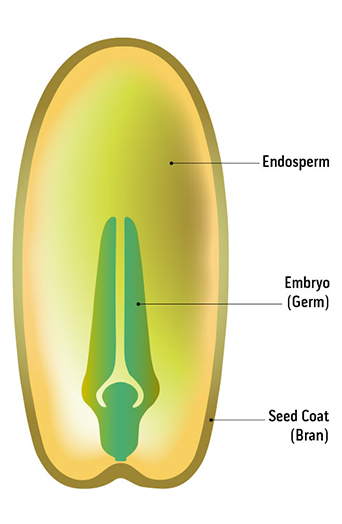Origin: a Latin derivative
meaning "Gift of the Earth."
Part 2: Plant Structure-Fruits and Seeds
In flowering plants, the seeds formed during reproduction are held inside of the flower’s ovary. Seeds are composed of three main parts: the embryo, the endosperm, and the protective outer shell. The embryo (also referred to as the “germ”) is the part of the seed that will develop into the new plant. The endosperm stores a supply of food and nutrients needed to feed the embryo as it sprouts. Plants can be differentiated by the emergence of the first embryonic leaf which is known as a cotyledon. Plants that have either one or two cotyledons are known as monocotyledons (monocots) or dicotyledons (dicots). Examples of monocots, which are all herbaceous plants, are rice, onion, ginger, daffodil, banana grasses etc. Examples of dicots, which can be either herbaceous or woody, are basil, coriander, rose, apple, cinnamon etc. An energy source is critical for the life of the new plant because it cannot begin using photosynthesis to make its own food until it penetrates the Earth’s surface. Usually, the endosperm provides nutrients in the form of starch, but can also contain oils and protein. The protective outer shell (also referred to as the “bran”) is used for protecting the seed until the environmental conditions are optimal for growth. A seed is able to detect when these conditions are available based on temperature and moisture conditions. Temperature is important because it ensures that the plant will not freeze and that there is enough sunlight for photosynthesis. Water is absorbed by the seed causing it to swell. Eventually, the outer shell will split open allowing the seed to sprout.

In certain plants, the ovary can expand to become a fruit. Generally fruits have three characteristic layers: the skin or peel, the flesh (which can be wet or dry), and the inner layer that may contain a seed, tough stone, or pit. The main function of fruit is to distribute seeds to new locations where the plant might be able to grow. Like flowers, fruits are brightly colored, sweet to the taste, and have potent aromas. This attracts animals, birds, and insects to feast on the fruit and then deposit the seeds in a new location in their feces. Other ways that seeds can be transported is in the wind as plumes or fluff, floating on water, or by producing hooks, barbs, and stickers that allow them to attach to animal fur.
The citrus essential oils such as bergamot, lemon, lime, orange and tangerine are produced by cold-pressing the fruit rind. Essential oils that are produced by distillation of seeds include black pepper, coriander, fennel etc.





